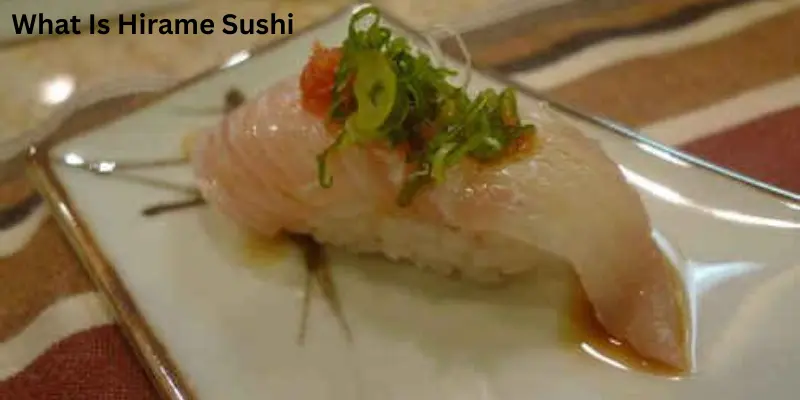What Is Hirame Sushi? Taste, Texture, and Tips
Published: 26 Sep 2025
Hirame is known as the “king of white fish” in Japanese sushi. Its pure taste, smooth texture, and beautiful look defined it uniquely. In winter, this flatfish becomes even more special. It produces rich fat that gives the flesh a golden look and a richer taste.
For sushi lovers, Hirame sushi is not just food—it is an experience. Every bite feels light, fresh, and pure. Chefs love it for its balance of softness and quality. That’s why Hirame has a permanent place at the sushi counter, loved by both beginners and experts.
What Is Hirame Sushi?
Hirame sushi is sushi made with a special flatfish called flounder or olive flounder. In Japan, it is known as Hirame and is popular for its soft, clean flavor. The fish has white meat that is soft but hard when eaten. Chefs often serve it as nigiri or sashimi. Hirame sushi is light, fresh, and perfect for people who enjoy delicate flavors.

Why Hirame Sushi is Special in Japan
Hirame sushi is famous in Japan for its delicate taste and smooth texture. The meat is light, soft, and not fishy, making it perfect for sushi and sashimi. Chefs enjoy it because it shows skill in preparation and cutting.
It is also seasonal and tasteful, with the best flavor in winter when the fish is fattier. Hirame represents freshness and refinement on the sushi plate. Many sushi lovers consider it a best choice that highlights delicate tastes and traditional Japanese techniques.
Types of Hirame Sushi
Fluke, or Hirame, is a favorite fish in Japanese cuisine because of its light flavor and smooth texture. It can be prepared in many delicious ways, from raw sushi to cooked dishes. Here are some popular dishes made with fluke:
Hirame Nigiri
Hirame nigiri is a classic sushi made with a slice of fluke over rice. It has a clean taste and a soft bite. Chefs often add a touch of wasabi or citrus to better its flavor.
Hirame Sashimi
Hirame sashimi is raw fluke served without rice. The thin slices highlight its mild, sweet taste. It’s often paired with soy sauce, ponzu, or a bit of wasabi.
Usuzukuri (Thin-Sliced Fluke)
Usuzukuri is fluke cut into paper-thin slices. The dish looks beautiful and tastes light. It’s usually served with ponzu sauce and garnished with herbs or radish.
Engawa Sushi (Fin Edge Cut)
Engawa comes from the fin edge of the fluke. It has a richer taste and a chewy texture. Many people see it as the most prized part of the fish.
Kobujime (Kelp-Marinated Fluke)
Kobujime is fluke wrapped in kelp to enhance its flavor. The kelp adds umami and makes the fish taste deeper. This traditional method also helps preserve the fish.
Grilled or Simmered Fluke Dishes
Fluke can also be grilled or gently simmered. Cooking gives the fish a warm, tender taste. These dishes are often seasoned lightly to keep the flavor fresh.
Hirame Fish Facts
Hirame is a special flatfish often used in sushi and sashimi. It is known for its mild taste and smooth texture. Here are some key facts about this unique fish:
- Scientific Name: Paralichthys olivaceus
- Common Names: Olive flounder, fluke, bastard halibut
- Japanese Name: (Hirame)
- Body: Flat with both eyes on the left side
- Habitat: Coastal waters, sandy or muddy sea bottoms
- Diet: Small fish, shrimp, and crabs
- Size: Can grow up to 1 meter long
- Special Trait: Can slightly change color to blend with the seabed
Seasonality & Quality Factors
Hirame is a seasonal fish that changes taste with the time of year. Its fat, texture, and flavor are best during cold months. Knowing these factors helps in choosing the best quality fish.
- Best Season: Winter is the peak time for rich, tasty Hirame.
- Fat Content: Colder months increase fat, making the fish softer and richer.
- Aging: Proper aging improves flavor and gives a smoother texture.
- Size: Medium-sized Hirame is often more tender than very large ones.
- Wild vs Farmed: Wild Hirame is prized for cleaner taste, while farmed is more common.
Taste and Texture of Hirame
Hirame has a mild and clean taste. It is not strong or fishy, which makes it very refreshing. The texture is smooth and slightly firm, with a gentle bite. In winter, when the fish has more fat, the flavor becomes richer and the flesh feels softer.
Safety and Quality Tips
Eating raw Hirame is safe if handled correctly. Choosing fresh and high-quality fish ensures the best taste and avoids health risks. Here are some important tips to keep in mind:
- Freshness: Look for clear eyes and firm flesh.
- Smell: Fresh Hirame should have a clean, sea-like aroma.
- Color: The flesh should be pale and slightly translucent.
- Freezing: Raw Hirame should be frozen properly to kill parasites.
- Source: Buy from trusted suppliers or sushi restaurants.
- Handling: Keep the fish cold and avoid long exposure to room temperature.
Conclusion
Hirame sushi is a special and delicate dish loved in Japanese food. Its soft flavor, smooth texture, and elegant appearance make it a favorite for sushi and sashimi. Eating Hirame sushi is a simple way to enjoy fresh, high-quality seafood.
Knowing the best season, quality factors, and safe handling helps you enjoy Hirame sushi fully. Whether served as nigiri, sashimi, or thin slices, Hirame sushi shows the skill of sushi chefs and the beauty of Japanese food tradition.
FAQs
Hirame has a mild, clean, and slightly sweet taste. It is not strong or fishy, and its smooth texture makes it refreshing and delicate, perfect for sushi and sashimi.
The best season is winter, when the fish has more fat and richer flavor. This is called kan-birame in Japan.
Fresh Hirame should have firm, pale flesh, clear eyes, and a clean, sea-like smell. Avoid fish that look dull or watery.
Hirame sushi is served as nigiri, sashimi, usuzukuri (thin slices), engawa (fin edge), or kobujime (kelp-marinated).
Yes, if it is properly handled and frozen to kill parasites. Always buy from trusted suppliers or restaurants for safety.
Hirame is a flatfish, also called olive flounder or bastard halibut. It has both eyes on the left side and belongs to the white-fleshed fish group called shiromi in Japan.

- Be Respectful
- Stay Relevant
- Stay Positive
- True Feedback
- Encourage Discussion
- Avoid Spamming
- No Fake News
- Don't Copy-Paste
- No Personal Attacks

- Be Respectful
- Stay Relevant
- Stay Positive
- True Feedback
- Encourage Discussion
- Avoid Spamming
- No Fake News
- Don't Copy-Paste
- No Personal Attacks





